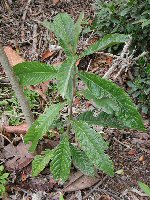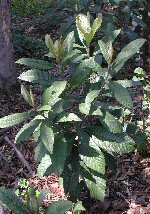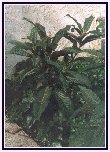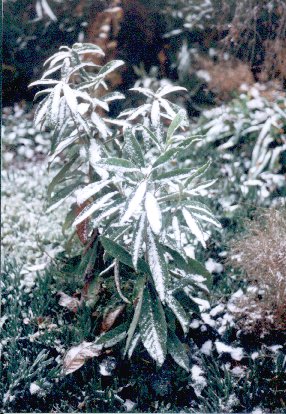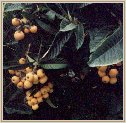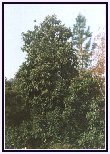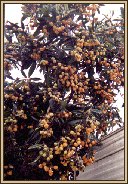|
INFORMATION 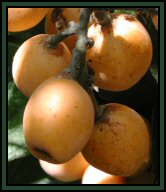
Loquat Fruit The loquat tree [pronounced: "LOH-kwaht"] produces one of the first fruits in the spring season. The tree sets out flowers during the winter months.  The tartly sweet, aromatic 1 1/2" golden-yellow to orange
fruit that resembles an apricot in size and color usually ripen in mid
to late spring The juicy, crisp flesh is pale yellow to orange and has a delicate,
sweetly tart cherry-like or pear-like flavor. It surrounds 1 to 5 seeds that are about
the size of apricot pits or smaller. The seeds are smooth and rounded but somewhat flatted
on one or two sides. The yellow fleshy edible fruits are eaten raw, cooked, or
made into jelly.
The tartly sweet, aromatic 1 1/2" golden-yellow to orange
fruit that resembles an apricot in size and color usually ripen in mid
to late spring The juicy, crisp flesh is pale yellow to orange and has a delicate,
sweetly tart cherry-like or pear-like flavor. It surrounds 1 to 5 seeds that are about
the size of apricot pits or smaller. The seeds are smooth and rounded but somewhat flatted
on one or two sides. The yellow fleshy edible fruits are eaten raw, cooked, or
made into jelly.
Beautiful evergreen Loquat trees in your backyard will provide tasty fruit for sustenance, leaves for tea, and the pits can be used for medicinal purposes or to improve health. MORE INFORMATION This large evergreen shrub or tree that grows to about 20 feet tall and 10 feet wide in about 10 years originated in China. The leaves are usually 6 to 12 inches long, 2 to 4 inches wide, look and feel leathery and somewhat veiny, and have sawtooth edges. They are dark green on top and the undersides are covered with a lightly dusted tan fuzz. The groups of 6 to 8 inch clusters of small, fragrant, creamy white flowers usually bloom in the late fall or early winter. Although these hardy trees prefer to grow in the direct sun, , they will also do well in partial shade and sometimes in full shade. . They grow well on a variety of soils from light sandy loam to heavy clay and even limestone soils, but will not tolerate standing water. The trees prefer good drainage and or well-drained moist soil. Most loquat trees are drought tolerant, but will produce better quality fruit with regular, deep watering. Well established trees can tolerate temperatures as low as 12° F. Flower buds may die at temperatures below 19° F. Flowers do well down to temperatures of 26° F. Temperatures below 25° F can kill the seed, which may cause the fruit to eventually fall. Extreme summer heat (above 105° F) can be detrimental to the crop. Dry, hot winds (100° F and above) can cause leaf scorch. Trees over 3.5 feet tall are available but are not delivered through the mails but are to be picked up at our place by appointment only. 
INITIAL STAGES of GROWTH To improve growth, cover the soil near tree with compost and place mulch over the compost. Water thoroughly initially but do not over water especially after tree becomes established. Do not allow standing stale water. This is what
can be expected, but not to be relied upon, assuming the tree is well taken care of: First year Second year Third year Fourth year Fifth year Sixth year Seventh year Eight year Ninth year Tenth Year and beyond This is an average synopsis and may vary considerably depending on type of soil, climate, amount of shade or sun, available nutrients in soil, water (too much or too little), Ph, physical damage, leaf eating insects, herbicides and or insecticides used on the tree or plants nearby, climate zone, extreme temperatures (too high or too low), root space adequate or not adequate (root bound) for growth, etc. 



|
>
Jack Slevkoff's Enterprises
provides...
LOQUAT TREES (Eriobotrya japonica) Also called May Apple, Japanese medlar, and Japanese plum In Mandarin Chinese, the name is “pipa”. In Japan, the fruit are called “biwa”. People in some European countries such as Spain and Italy call the loquat fruit “nispero”, “nipero”, “mespel”, or “nespoli.” German and Sweedish: mispel; Hungaian: naspolya. In the Middle East they are called “acadinias.” Click on photos to enlarge
Grow one or two in your backyard or send as a gift to that SPECIAL someone.



For those who come in the back door such as through a search engine, our web-site (URL) address is "http://www.LoquatWorld.com" 
Since the Seventeenth day of the Tenth month
anno Domini Two thousand seven You are visitor Thank you! |
WE PROVIDE
Most of Our loquat trees are propagated/grown from loquat seed pits in a natural selection environment by cross pollination among a variety of various fruit bearing loquat trees as nature's God intended. Some trees produce "tight clusters" of fruit and some have fruit on long stems I call "spiders." The fruit size can vary from small apricot size to large rounds the size of baseballs. Some fruit are round, some oblong, and others egg shaped ovals. Some are more tart than others and some are more sweeter, flavorful, and or tastier than others. Some ripen earlier and some later for a longer season. Each tree is different from another. It gives us a lot of variety whereby We are not locked into just certain patent types. We basically create Our own varieties. When We pack the fruit for mail delivery, the smaller ones fill in the voids and support the larger fruit. The trees We provide are not grafted. Our loquat trees will produce fruit, but We do not know what the fruit of each tree is going to look like or taste like until it is in a productive state. The loquat trees We provide are self-pollinating. However, the more trees, the better. When TREES ARRIVE When plants arrive, soak roots immediately in water with vitamin B-1 or some other root stimulator as directed on label for at least 1/2 hour. Plant right away after soaking. Don't let the roots dry out. Remove any damaged leaves or stems. We purposely cut off leaves to keep tree from dehydrating and to encourage new growth. Some new leaf growth may become wilted and possibly die back or some leafs may fall off. Don't be alarmed. These are very hardy trees and will come out of shock and be thriving plants once again. Recommended PLANTING INSTRUCTIONS 1. These trees will eventually become a fairly good sized tree in about twenty years and may have a canopy diameter of about 20 feet or more. So space accordingly. Plant the loquat trees no closer than 10 feet, preferably 20 feet from each other, other trees, and or buildings. To keep the tree smaller or more compact, prune or nip the buds occasionally. 2. I had already cut off some leaves and stems before sending. I believe that it would be even better to cut off more leaves and leave the best two or three. Too many leaves tend to sap the energy and moisture from the tree. I would leave a few of leaves so that they can provide some energy from the sun or light while the roots are getting re-established in their new location. It is okay for the remaining leaves to droop or even die off eventually. Once the roots are re-established in a few months, new growth should appear. 3. Dig a circular hole about two feet wide and about a foot deep, mix in some composted organic material with the native soil. Loquat trees like rich soils and rich soils maintain moisture better. 4. When you receive the trees, remove the coverings and place the roots in some water containing Vitamin B-1 for 10 minutes to half hour and then put some root hormone on some of the thicker roots or woody roots to help stimulate new root growth. 5. If your planting area has clay soil and or hardpan, create a mound and plant the tree on top of the mound so the water has a place to drain away from the root system. Clay soil and or hardpan locks in and or prevents water from draining, 6. When planting, spread the roots out from the stem and at about a 20 degree to 45 degree slant from the surface except for a tap root (vertical) if one exists. Let it remain vertical. 7. Keep the bottom of the stem of the plant at least 1" to 3" above the surrounding soil surface. But be sure all the roots are submerged in the soil. 8. Tie the trees to a stake to help support and train the tree trunk as it grows so as to have the trunk grow straight and vertically upward and to withstand strong winds. 9. Create a little ditch about 6" deep around the tree about 10" out from the center of the tree for initial deep watering and for future watering. 10. Water the newly planted tree as soon as possible so the tree roots do not dry out. The purpose of the first watering is to saturate the ground around the tree to settle the dirt around the tree and to eliminate voids in the soil around the rooting area. 11. Place some mulch (2" to 4") over the surface of the ground around the tree from the tree trunk to about two feet out from the tree The mulch will keep in the moisture and provide nutrients while the mulch deteriorates. To improve growth, first cover the soil near tree with composted matter and then place mulch over the compost. 12. Water intermittently accordingly to weather and soil conditions. Do not let the soil dry out. If the soil is too dry, the roots will dry up and eventually the tree may die. For best results, the soil must remain moist but not soaking wet. Do not allow standing water which will become stagnant and cause root rot. You can also water with sprinkler from 10 to 20 minutes every two to four days depending on hot weather conditions. 



|
|||||||||||||||||||||||||||||||||||||||||||||||||||||||||||||||
